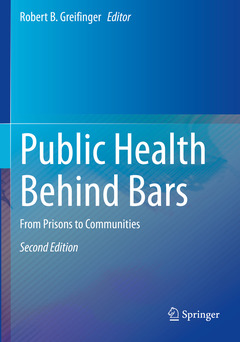Public Health Behind Bars (2nd Ed., 2nd ed. 2022) From Prisons to Communities
Coordonnateur : Greifinger Robert B.

Public Health Behind Bars From Prisons to Communities examines the burden of illness in the growing prison population, and analyzes the impact on public health as prisoners are released. This book makes a timely case for correctional health care that is humane for those incarcerated and beneficial to the communities they reenter.
Robert B. Greifinger, MD is a healthcare policy and quality management consultant. His work focuses on design, management, and quality improvement in correctional healthcare systems. He has extensive experience in the development and management of complex community and institutional healthcare programs, and strengths in the bridging of clinical and public policy interests.
Dr. Greifinger has published extensively in the area of correctional health care. He has been a frequent speaker on public policy, communicable disease control and quality management in corrections. Dr. Greifinger was the principal investigator for the Report to Congress on Seizing Public Health Opportunities through Correctional Health Care, published in 2002. He was Co-Editor of the International Journal of Prisoner Health from 2010 - 2016. Dr. Greifinger is the editor of Public Health Behind Bars: From Prisons to Communities (1st Edition, 2007; 2nd Edition, 2022), Springer, New York. He currently serves as the Federal Court-appointed medical monitor for the jails in Miami, Florida; New Orleans, Louisiana; and Albuquerque, New Mexico.
Is the sole scholarly treatise on the interface of public health and public policy with incarcerated people
Updates the first edition and adds discussion of relevant topics, with authorship of more than 60 contributors drawn from public health, correctional health, civil rights law, and sociology
Examines the burden of illness in the growing prison population and analyzes the considerable impact on public health as prisoners are released
Makes a timely case for correctional health care that is humane for those incarcerated and beneficial to the communities they re-enter, with authors offering affirmative recommendations toward that evolutionary step
Identifies the most compelling health problems behind bars (including communicable disease, mental illness, addiction, and suicide), pinpoints systemic barriers to care, and explains how correctional medicine can shift from emergency or crisis care to primary care and prevention
Outlines strategies that link community health resources to correctional facilities so that prisoners can transition to the community without unnecessarily taxing public resources or falling through the cracks
Date de parution : 10-2022
Ouvrage de 520 p.
17.8x25.4 cm
Date de parution : 10-2021
Ouvrage de 520 p.
17.8x25.4 cm
Thèmes de Public Health Behind Bars :
Mots-clés :
Correctional health care; Crime and criminal justice; HIV prevention; Health promotion; International Public Health; Law and health; Prevention and Control; Prisoner health; Prisons and health; Public policy; prison and jail health care; morbidity in prisons and jails; re-entry and community reintegration; opiate substitution in prisons and jails; female prisoner's health; inmate suicide; communicable disease in prison; prisoner litigation; medicalization of execution; aging inmates


